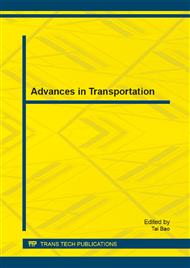p.1076
p.1080
p.1084
p.1089
p.1093
p.1097
p.1102
p.1107
p.1114
Study of Characteristics of Phone Distraction on Drivers and its Influence on Traffic Safety Operation
Abstract:
In order to study on the characteristics of phone distraction of drivers and its effect on traffic safety and traffic flow. Driver Behavior Questionnaire and Driver Skill Inventory surveys of 139 drivers were conducted combined with the basic situation of China, the SPSS software was used to analyze the processing of the survey results. The study found that the phone distraction will reduce drivers recognition ability of emergency event and driving performance, prolonging the reaction time of driver, it also has certain influence on lane changing behavior and safety following distance. In view of the problems existing in the research, four advices of driving training, publicity of legislation, punishment and technology were put forward.
Info:
Periodical:
Pages:
1093-1096
Citation:
Online since:
January 2014
Price:
Сopyright:
© 2014 Trans Tech Publications Ltd. All Rights Reserved
Share:
Citation:


